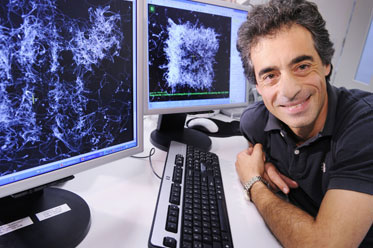| Posted: May 20, 2009 |
Grant to develop a new class of solar-powered nanosensors for pollution monitoring |
|
(Nanowerk News) A $1.3 million State Government grant will help Queensland University of Technology create a new class of solar-powered nano-sensors capable of detecting pollution and monitoring the environment in remote areas.
|
|
Lead researcher Professor Nunzio Motta, from QUT's School of Engineering Systems, said nanotechnology had the potential to revolutionise current farming and environmental management techniques.
|
|
Professor Motta said up until now it had been too costly and very difficult to collect and monitor data revealing the environmental conditions experienced in remote areas.
|
 |
| Professor Nunzio Motta
|
|
"These sophisticated nano-sensors which we are developing and which will use very little power, will provide a more accurate picture of what is happening in the environment, and will help farmers monitor their crops in remote areas," he said.
|
|
Professor Motta said the nano-sensors, which were located in a self-contained box and could be placed where needed, were based on microscopic tubes and wires too small to be seen by the naked eye.
|
|
"The nanotubes being developed at QUT are tiny carbon tubes with a diameter of a few millionths of a millimetre, much smaller than a human hair, and will be covered by the sensing molecules," he said.
|
|
"The nanowires which are being developed in Italy, are metallic oxide needles of the same size, and will not require sensing molecules.
|
|
"Their hair-like structure increases the sensitivity of the detector because of the huge surface exposed with respect to conventional flat sensors."
|
|
|
|
Professor Motta said the sensors would be powered by a new kind of solar cell developed in Australia by Dyesol, and would transmit data to monitoring stations using radio or Universal Mobile Telecommunications System (UMTS) technology.
|
|
"This will provide a low-cost method to monitor air, water, land and crop conditions, and assist in the control of pollution levels and gas and carbon emissions," he said.
|
|
"What we have proposed is that in the first year we will develop the nano-structures, in the second year we will work on the electronics, and in the third year we will deploy the sensors for testing."
|
|
The project is a collaboration involving QUT, Central Queensland University, the Brescia and Roma Tor Vergata universities in Italy, and Dyesol, one of Australia's leading suppliers of solar technology.
|

